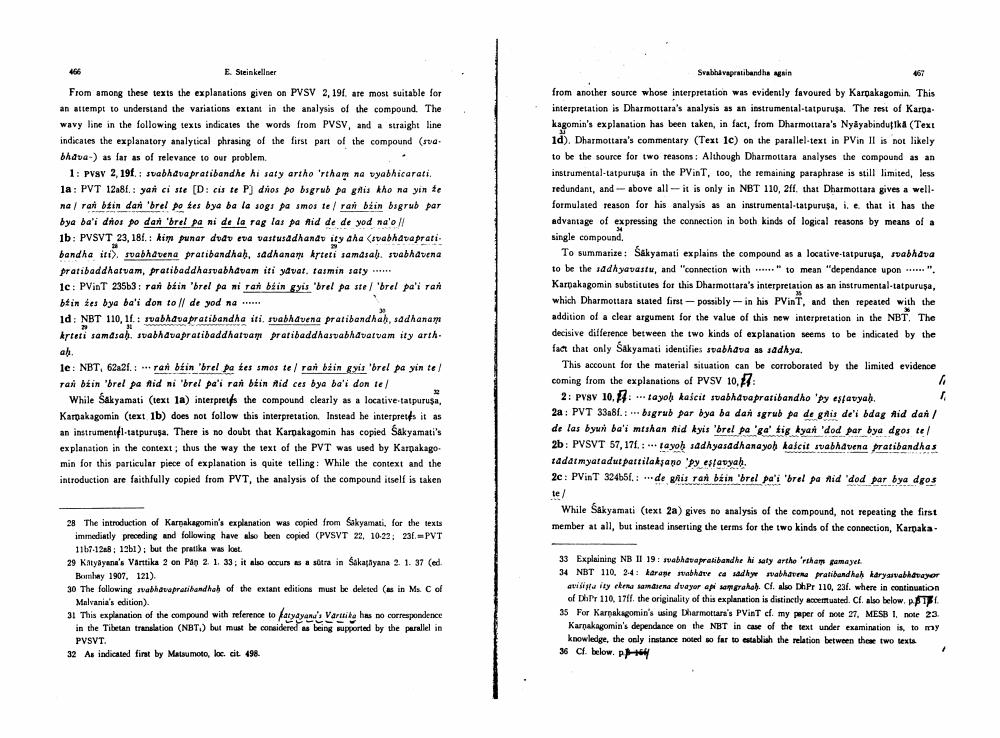Book Title: Svabhavarat Bandha Again Author(s): Ernat Steinkellner Publisher: Ernat Steinkellner View full book textPage 6
________________ 466 E. Steinkellner From among these texts the explanations given on PVSV 2,19f. are most suitable for an attempt to understand the variations extant in the analysis of the compound. The wavy line in the following texts indicates the words from PVSV, and a straight line. indicates the explanatory analytical phrasing of the first part of the compound (sva bhava-) as far as of relevance to our problem. 1: PVSV 2,19f.: svabhavapratibandhe hi saty artho 'rtham na vyabhicarati. la: PVT 12a8f.: yan ci ste [D: cis te P) dños po bsgrub pa ghis kho na yin te naran bin dan 'brel po źes bya ba la sogs pa smos te ran biin bsgrub par bya ba'i dños po dan 'brel pa ni de la rag las pa Aid de de yod na'o 28 1b: PVSVT 23, 181.: kim punar dvav eva vastusadhanav ity aha (svabhavaprati bandha iti svabhavena pratibandhah, sadhanam krteti samasah. svabhavena pratibaddhatvam, pratibaddhasvabhavam iti yavat. tasmin saty...... 1c: PVinT 235b3: ran bźin 'brel pa ni ran biin gyis 'brel pa stel 'brel pa'i ran btin źes bya ba'i don to // de yod na..... 31 Id: NBT 110, 1f.: svabhavapratibandha iti. svabhavena pratibandhaḥ, sadhanam kyteti samasaḥ, svabhavapratibaddhatvam pratibaddhasvabhavatvam ity arth ab. le: NBT, 62a2f.: ran béin 'brel pa tes smos te ran biin gyis 'brel pa yin te Tai bźin 'brel pa fid ni 'brel pa'i ran béin Rid ces bya ba'i don te While Sakyamati (text 1a) interprets the compound clearly as a locative-tatpurusa, Karnakagomin (text 1b) does not follow this interpretation. Instead he interpretes it as an instrumentel-tatpurusa. There is no doubt that Karpakagomin has copied Sakyamati's explanation in the context; thus the way the text of the PVT was used by Karnakagomin for this particular piece of explanation is quite telling: While the context and the introduction are faithfully copied from PVT, the analysis of the compound itself is taken 30 2 28 The introduction of Karnakagomin's explanation was copied from Sakyamati, for the texts immediatly preceding and following have also been copied (PVSVT 22, 10-22; 236=PVT 11b7-128; 12b1); but the pratika was lost. 29 Katyayana's Varttika 2 on Pan 2. 1. 33; it also occurs as a sutra in Sakatiyana 2. 1. 37 (ed. Bombay 1907, 121). 30 The following vabhavapratibandhah of the extant editions must be deleted (as in Ms. C of Malvania's edition). 31 This explanation of the compound with reference to fatyayana's Varttika has no correspondence in the Tibetan translation (NBT.) but must be considered as being supported by the parallel in PVSVT. 32 As indicated first by Matsumoto, loc. cit. 498. Svabhavapratibandha again from another source whose interpretation was evidently favoured by Karpakagomin. This interpretation is Dharmottara's analysis as an instrumental-tatpurusa. The rest of Karpa kagomin's explanation has been taken, in fact, from Dharmottara's Nyāyabinduţika (Text 1d). Dharmottara's commentary (Text 1c) on the parallel-text in PVin II is not likely to be the source for two reasons: Although Dharmottara analyses the compound as an instrumental-tatpurusa in the PVinT, too, the remaining paraphrase is still limited, less redundant, and above all-it is only in NBT 110, 2ff. that Dharmottara gives a wellformulated reason for his analysis as an instrumental-tatpuruşa, i. e. that it has the advantage of expressing the connection in both kinds of logical reasons by means of a single compound. To summarize: Šakyamati explains the compound as a locative-tatpuruşa, svabhava to be the sadhyavastu, and "connection with to mean "dependance upon.". Karnakagomin substitutes for this Dharmottara's interpretation as an instrumental-tatpurusa, which Dharmottara stated first-possibly in his PVinT, and then repeated with the addition of a clear argument for the value of this new interpretation in the NBT. The decisive difference between the two kinds of explanation seems to be indicated by the fact that only Sakyamati identifies svabhava as sadhya. This account for the material situation can be corroborated by the limited evidence coming from the explanations of PVSV 10,7: tayoh kaścit svabhavapratibandho 'py estavyah. 2: PVSV 10, 2a: PVT 33a8f.: bigrub par bya ba dan sgrub pa de gnis de'i bdag Aid dan/ de las byun ba'i mtshan flid kyis 'brel pa 'ga' tig kyan 'dod par bya dgos te 2b: PVSVT 57, 171.: tayoḥ sadhyasadhanayoh kalcit svabhavena pratibandhas tadatmyatadut pattilaksano 'py estavyah. 2c: PVinT 324b5f. de ghis ran béin 'brel pa'i 'brel pa nid 'dod par bya dgos te/ 467 While Sakyamati (text 2a) gives no analysis of the compound, not repeating the first member at all, but instead inserting the terms for the two kinds of the connection, Karpaka " " 33 Explaining NB II 19: svabhavapratibandhe hi saty artho 'rtham gamayet 34 NBT 110, 2-4 karane svabhave ca sadhye svabhavena pratibandhah karyasvabhavayor avisista ity ekena samasena dvayor api samgrahah. Cf. also DhPr 110, 23f. where in continuation of DhPr 110, 17ff. the originality of this explanation is distinctly accentuated. Cf. also below. pTI 35 For Karnakagomin's using Dharmottara's PVinT cf. my paper of note 27, MESB 1, note 23. Karnakagomin's dependance on the NBT in case of the text under examination is, to may knowledge, the only instance noted so far to establish the relation between these two texts 36 Cf. below. pPage Navigation
1 ... 4 5 6 7 8 9 10 11
